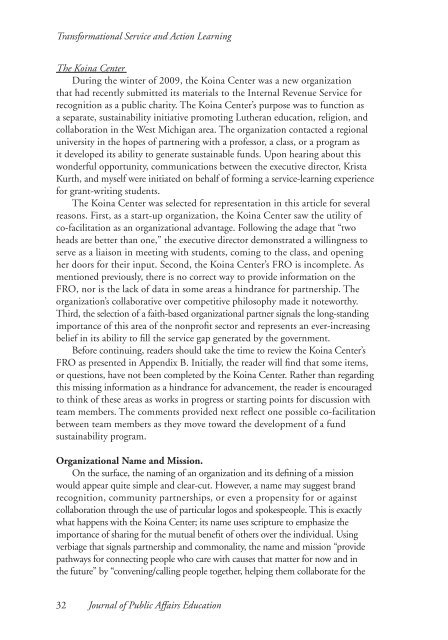Journal of Public Affairs Education
Create successful ePaper yourself
Turn your PDF publications into a flip-book with our unique Google optimized e-Paper software.
Transformational Service and Action Learning<br />
The Koina Center<br />
During the winter <strong>of</strong> 2009, the Koina Center was a new organization<br />
that had recently submitted its materials to the Internal Revenue Service for<br />
recognition as a public charity. The Koina Center’s purpose was to function as<br />
a separate, sustainability initiative promoting Lutheran education, religion, and<br />
collaboration in the West Michigan area. The organization contacted a regional<br />
university in the hopes <strong>of</strong> partnering with a pr<strong>of</strong>essor, a class, or a program as<br />
it developed its ability to generate sustainable funds. Upon hearing about this<br />
wonderful opportunity, communications between the executive director, Krista<br />
Kurth, and myself were initiated on behalf <strong>of</strong> forming a service-learning experience<br />
for grant-writing students.<br />
The Koina Center was selected for representation in this article for several<br />
reasons. First, as a start-up organization, the Koina Center saw the utility <strong>of</strong><br />
co-facilitation as an organizational advantage. Following the adage that “two<br />
heads are better than one,” the executive director demonstrated a willingness to<br />
serve as a liaison in meeting with students, coming to the class, and opening<br />
her doors for their input. Second, the Koina Center’s FRO is incomplete. As<br />
mentioned previously, there is no correct way to provide information on the<br />
FRO, nor is the lack <strong>of</strong> data in some areas a hindrance for partnership. The<br />
organization’s collaborative over competitive philosophy made it noteworthy.<br />
Third, the selection <strong>of</strong> a faith-based organizational partner signals the long-standing<br />
importance <strong>of</strong> this area <strong>of</strong> the nonpr<strong>of</strong>it sector and represents an ever-increasing<br />
belief in its ability to fill the service gap generated by the government.<br />
Before continuing, readers should take the time to review the Koina Center’s<br />
FRO as presented in Appendix B. Initially, the reader will find that some items,<br />
or questions, have not been completed by the Koina Center. Rather than regarding<br />
this missing information as a hindrance for advancement, the reader is encouraged<br />
to think <strong>of</strong> these areas as works in progress or starting points for discussion with<br />
team members. The comments provided next reflect one possible co-facilitation<br />
between team members as they move toward the development <strong>of</strong> a fund<br />
sustainability program.<br />
Organizational Name and Mission.<br />
On the surface, the naming <strong>of</strong> an organization and its defining <strong>of</strong> a mission<br />
would appear quite simple and clear-cut. However, a name may suggest brand<br />
recognition, community partnerships, or even a propensity for or against<br />
collaboration through the use <strong>of</strong> particular logos and spokespeople. This is exactly<br />
what happens with the Koina Center; its name uses scripture to emphasize the<br />
importance <strong>of</strong> sharing for the mutual benefit <strong>of</strong> others over the individual. Using<br />
verbiage that signals partnership and commonality, the name and mission “provide<br />
pathways for connecting people who care with causes that matter for now and in<br />
the future” by “convening/calling people together, helping them collaborate for the<br />
32 <strong>Journal</strong> <strong>of</strong> <strong>Public</strong> <strong>Affairs</strong> <strong>Education</strong>



